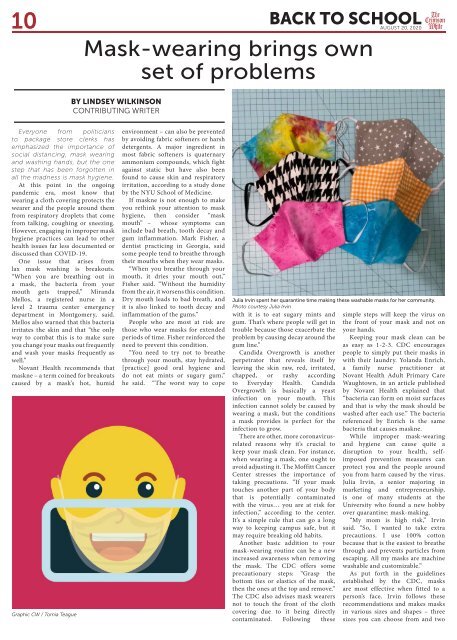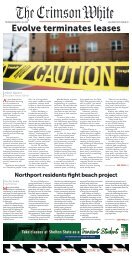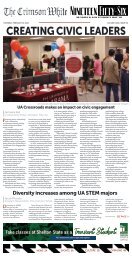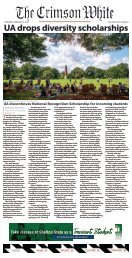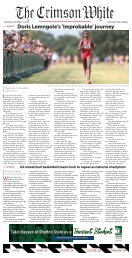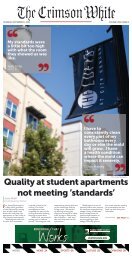CW Back to School Edition, Fall 2020
Students are finally back on campus. There’s a not-insignificant chance that some of those students develop “maskne” while they’re here. Maskne or no, Nate Oats is ready to welcome them back, and the all-SEC football schedule has finally been released. Find all this and more in our first edition of the fall.
Students are finally back on campus. There’s a not-insignificant chance that some of those students develop “maskne” while they’re here. Maskne or no, Nate Oats is ready to welcome them back, and the all-SEC football schedule has finally been released. Find all this and more in our first edition of the fall.
You also want an ePaper? Increase the reach of your titles
YUMPU automatically turns print PDFs into web optimized ePapers that Google loves.
10 BACK TO SCHOOL<br />
AUGUST 20, <strong>2020</strong><br />
Mask-wearing brings own<br />
set of problems<br />
BY LINDSEY WILKINSON<br />
CONTRIBUTING WRITER<br />
Everyone from politicians<br />
<strong>to</strong> package s<strong>to</strong>re clerks has<br />
emphasized the importance of<br />
social distancing, mask wearing<br />
and washing hands, but the one<br />
step that has been forgotten in<br />
all the madness is mask hygiene.<br />
At this point in the ongoing<br />
pandemic era, most know that<br />
wearing a cloth covering protects the<br />
wearer and the people around them<br />
from respira<strong>to</strong>ry droplets that come<br />
from talking, coughing or sneezing.<br />
However, engaging in improper mask<br />
hygiene practices can lead <strong>to</strong> other<br />
health issues far less documented or<br />
discussed than COVID-19.<br />
One issue that arises from<br />
lax mask washing is breakouts.<br />
“When you are breathing out in<br />
a mask, the bacteria from your<br />
mouth gets trapped,” Miranda<br />
Mellos, a registered nurse in a<br />
level 2 trauma center emergency<br />
department in Montgomery, said.<br />
Mellos also warned that this bacteria<br />
irritates the skin and that “the only<br />
way <strong>to</strong> combat this is <strong>to</strong> make sure<br />
you change your masks out frequently<br />
and wash your masks frequently as<br />
well.”<br />
Novant Health recommends that<br />
maskne – a term coined for breakouts<br />
caused by a mask’s hot, humid<br />
Graphic <strong>CW</strong> / Tomia Teague<br />
environment – can also be prevented<br />
by avoiding fabric softeners or harsh<br />
detergents. A major ingredient in<br />
most fabric softeners is quaternary<br />
ammonium compounds, which fight<br />
against static but have also been<br />
found <strong>to</strong> cause skin and respira<strong>to</strong>ry<br />
irritation, according <strong>to</strong> a study done<br />
by the NYU <strong>School</strong> of Medicine.<br />
If maskne is not enough <strong>to</strong> make<br />
you rethink your attention <strong>to</strong> mask<br />
hygiene, then consider “mask<br />
mouth” – whose symp<strong>to</strong>ms can<br />
include bad breath, <strong>to</strong>oth decay and<br />
gum inflammation. Mark Fisher, a<br />
dentist practicing in Georgia, said<br />
some people tend <strong>to</strong> breathe through<br />
their mouths when they wear masks.<br />
“When you breathe through your<br />
mouth, it dries your mouth out,”<br />
Fisher said. “Without the humidity<br />
from the air, it worsens this condition.<br />
Dry mouth leads <strong>to</strong> bad breath, and<br />
it is also linked <strong>to</strong> <strong>to</strong>oth decay and<br />
inflammation of the gums.”<br />
People who are most at risk are<br />
those who wear masks for extended<br />
periods of time. Fisher reinforced the<br />
need <strong>to</strong> prevent this condition.<br />
“You need <strong>to</strong> try not <strong>to</strong> breathe<br />
through your mouth, stay hydrated,<br />
[practice] good oral hygiene and<br />
do not eat mints or sugary gum,”<br />
he said. “The worst way <strong>to</strong> cope<br />
Julia Irvin spent her quarantine time making these washable masks for her community.<br />
Pho<strong>to</strong> courtesy Julia Irvin<br />
with it is <strong>to</strong> eat sugary mints and<br />
gum. That’s where people will get in<br />
trouble because those exacerbate the<br />
problem by causing decay around the<br />
gum line.”<br />
Candida Overgrowth is another<br />
perpetra<strong>to</strong>r that reveals itself by<br />
leaving the skin raw, red, irritated,<br />
chapped, or rashy according<br />
<strong>to</strong> Everyday Health. Candida<br />
Overgrowth is basically a yeast<br />
infection on your mouth. This<br />
infection cannot solely be caused by<br />
wearing a mask, but the conditions<br />
a mask provides is perfect for the<br />
infection <strong>to</strong> grow.<br />
There are other, more coronavirusrelated<br />
reasons why it’s crucial <strong>to</strong><br />
keep your mask clean. For instance,<br />
when wearing a mask, one ought <strong>to</strong><br />
avoid adjusting it. The Moffitt Cancer<br />
Center stresses the importance of<br />
taking precautions. “If your mask<br />
<strong>to</strong>uches another part of your body<br />
that is potentially contaminated<br />
with the virus… you are at risk for<br />
infection,” according <strong>to</strong> the center.<br />
It’s a simple rule that can go a long<br />
way <strong>to</strong> keeping campus safe, but it<br />
may require breaking old habits.<br />
Another basic addition <strong>to</strong> your<br />
mask-wearing routine can be a new<br />
increased awareness when removing<br />
the mask. The CDC offers some<br />
precautionary steps: “Grasp the<br />
bot<strong>to</strong>m ties or elastics of the mask,<br />
then the ones at the <strong>to</strong>p and remove.”<br />
The CDC also advises mask wearers<br />
not <strong>to</strong> <strong>to</strong>uch the front of the cloth<br />
covering due <strong>to</strong> it being directly<br />
contaminated. Following these<br />
simple steps will keep the virus on<br />
the front of your mask and not on<br />
your hands.<br />
Keeping your mask clean can be<br />
as easy as 1-2-3. CDC encourages<br />
people <strong>to</strong> simply put their masks in<br />
with their laundry. Yolanda Enrich,<br />
a family nurse practitioner at<br />
Novant Health Adult Primary Care<br />
Waugh<strong>to</strong>wn, in an article published<br />
by Novant Health explained that<br />
“bacteria can form on moist surfaces<br />
and that is why the mask should be<br />
washed after each use.” The bacteria<br />
referenced by Enrich is the same<br />
bacteria that causes maskne.<br />
While improper mask-wearing<br />
and hygiene can cause quite a<br />
disruption <strong>to</strong> your health, selfimposed<br />
prevention measures can<br />
protect you and the people around<br />
you from harm caused by the virus.<br />
Julia Irvin, a senior majoring in<br />
marketing and entrepreneurship,<br />
is one of many students at the<br />
University who found a new hobby<br />
over quarantine: mask-making.<br />
“My mom is high risk,” Irvin<br />
said. “So, I wanted <strong>to</strong> take extra<br />
precautions. I use 100% cot<strong>to</strong>n<br />
because that is the easiest <strong>to</strong> breathe<br />
through and prevents particles from<br />
escaping. All my masks are machine<br />
washable and cus<strong>to</strong>mizable.”<br />
As put forth in the guidelines<br />
established by the CDC, masks<br />
are most effective when fitted <strong>to</strong> a<br />
person’s face. Irvin follows these<br />
recommendations and makes masks<br />
in various sizes and shapes – three<br />
sizes you can choose from and two


